Early Stage Reasearcher (ESR)
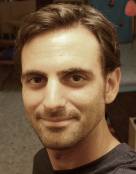 |
Chance Michael Coughenour - ESR1Institute for Photogrammetry, University of Stuttgart, GermanyUntil 14/06/2016 |
Originally from the United States, he was living in Spain for five years before joining the ITN-DCH project. His involvement on the project is entitled Automated 3D/4D Data Collection and Processing using Terrestrial LiDAR and Photogrammetry. Chance’s academic background ranges from archaeology and history to computer science. He received his BA in History at West Virginia University in the United States where he focused on the historiography of the British Empire in the founding of Hong Kong. Later, he obtained his MA in Archaeology and Heritage through distance learning with the University of Leicester in England. The primary objective of his MA research was focused on Classic Maya landscape archaeology and ritualistic assemblages. Recently, he finished a specialized Master’s course in Virtual Archaeology and Heritage directed by the Spanish Society of Virtual Archaeology. Over the past few years he has participated in the topographic survey and excavations of a Classic Maya commoner site with the Rio Bravo Archaeological Survey in northwestern Belize. Since 2012, he has been the Mapping Director of the project. He has also taken part in other archaeological projects in the Moche Valley of Peru and a Spanish Civil War site near Madrid.When he isn’t at his desk or working in the field, he keeps himself busy with reading, skiing, cycling, tennis, and hiking. |
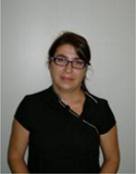 |
Magdalena Ramos Calles - ESR23D Optical Metrology (3DOM) unit, Bruno Kessler Foundation (FBK), Trento, ItalyUntil 13/07/2016 |
Born in the south of Spain, after her studies in Geodesy and Cartography, she started specializing in close-range photogrammetry, recording Spanish monuments and historical buildings (e.g. Sta. Marías’ Fountain, Sto. Domingo de Silos’ Church, etc.) in collaboration with Jaen University (Photogrammetric and Topometric Systems research group). She moved afterwards to the north of Spain to work as a technical cartographer in a private enterprise where she dealt with the production of cultural heritage orthophotos, camera calibration, image rectification, disparity maps, laser and photogrammetry data integration and other industrial applications. After having accomplished a Master’s course in “Virtual Archaeology and Heritage” directed by the Spanish Society of Virtual Archaeology, she began to think that recording cultural heritage is a multidisciplinary work that becomes easier by integrating multiple technologies. She finally joined the ITN-DCH consortium as the FBK Trento fellow with the project “Information and data fusion for cost-effective and precision digitisation in cultural heritage”. Apart from work, she loves photography and design, handicrafts, enjoys the countryside and trekking with her dog. |
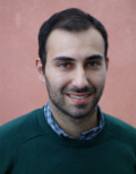 |
Diego Bellido Castaneda - ESR3ArcTron3DUntil 15/04/2017 |
Diego was born and grew up in Spain. He acquired his Bachelor degree in Engineering in Geomatics from the Santiago de Compostela University (USC). During his Bachelor studies, he gained the experience of developing a thesis in the field of remote sensing, studying the integration of radar and optical images in order to improve land cover techniques. After that, he went on his studies with a Master program in Geodesy and Cartography Engineering in Technical University of Madrid (UPM). He chose the specialization in acquisition and processing of Geomatic data, which focused on new technologies in geospatial acquisition; GNSS systems, laser scanner or new photogrammetric methods are some of the subjects. In his master thesis he analysed the possibility of UAV platforms to produce accurate products for an archaeology purpose. Data acquisition was done in a 7 days campaign in the archaeological site of Mleiha, Sharjah Emirate (UAE). Thanks to this work he was able to participate in the Erasmus Intensive Programme entitled “ICT at the Service of Cultural Heritage” held in Rhodes Island in July 2013. Since 2014 he was working as a Geospatial Data Analyst for FTTH project before joining the ITN-DCH at ArcTron3D. In his free time, he enjoys sports, specially football, tennis and running. He loves nature, travelling and have a good time with my friends. |
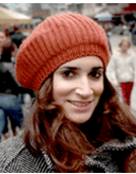 |
Elisavet Konstantina Stathopoulou - ESR4National Technical University of Athens, GreeceUntil 31/10/2016 |
She was born and grew up in Greece. Before joining the ITN-DCH project she had been living in Berlin, Germany for almost three years where she studied and worked on university projects. She possesses a Diploma from the National Technical University of Athens (NTUA) in Rural and Surveying Engineering and a M.Sc. in Geodesy and Geoinformation Science from Technische Universität Berlin (TUB). As an undergraduate student she participated in the As a surveying engineer she is experienced in fields such as geodesy, remote sensing, and geographic information science. During her diploma studies her major was in photogrammetry and cartography with specialisation in the documentation of Cultural Heritage, participating in theoretical and field courses. Her diploma thesis investigated 3D models of complex architectural surfaces, applied to the Cathedral of the city of Valencia. While studying in TUB she further elaborated on relevant scientific areas such as computer vision, digital image processing and analysis, programming, adjustment calculation, database management, web cartography etc. Meanwhile, she was a student research assistant in Geodesy and Adjustment Calculation Department, working on error propagation and laser scanning. Her Master of Science thesis developed an image matching algorithm for more accurate camera path estimation. Ellie has also taken part in the archaeological research programme “Mazotos Shipwreck project” of the University of Cyprus, as one of the photogrammetry engineers. Apart from studying she enjoys travelling and learning foreign languages. In her free time she usually does sport, listens to music, cooks or reads books. |
 |
Gina Stavropoulou - ESR5KULeuvenUntil 12/10/2016 |
Gina grew up in Athens, Greece. She recently moved to Leuven, Belgium in order to participate in the ITN-DCH project. Her involvement in the project is focused on the development of geometrically enriched computer vision algorithms for 3D reconstruction. Gina has acquired her Diploma of Rural and Surveying Engineering from the National Technical University of Athens. During her studies she chose a major specialisation in Photogrammetry, a field that gave her the opportunity to participate in course field trips explicitly related to the documentation of cultural heritage and 3D modelling. Her diploma thesis was focused on the development of an algorithm with a complementary interface for generating orthophotos and involved the algorithmic manipulation of both images and three dimensional point clouds. Driven by a desire to expand her knowledge more towards archaeology, Gina continued her studies with a M.Sc. in GIS & Archaeology in the University of Edinburgh. The multi disciplinarity of her masters gave her the opportunity not only to gain experience with various concepts of manipulation and distribution of geographical information but also to enhance her knowledge of recording, monitoring and archiving methods for cultural sites. In order to further develop her programming skills and to gain an insight into the field of computer vision, in her master thesis Gina implemented optical character recognition methods on old scanned maps, with final purpose the extraction of geographical information. In her free time, Gina is experimenting with one of her various hobbies, including video games, sketching and hiking. She also has an obsession with cinema and loves literature. |
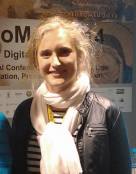 |
Anaïs Guillem - ESR6University of Ljublijana, SloveniaUntil 30/06/2016 |
Originally from Bordeaux in France, Anaïs has been living for the last 3 years in Nancy. She is both an architect and archaeologist. On the ITN-DCH project she works on the topic of Large scale spatiotemporal reconstruction. The contributions of computer technology and computer science have facilitated this interdisciplinary between architecture and archaeology. In parallel with her university studies in architecture, she followed the curriculum of the Master’s degree in Archaeology from the University of Bordeaux III, France, with a 3-year research project on an ancient theater in Xanthos, Turkey. Her interest in archaeology continues to be present in her current research. Her academic work for the Diploma in Architecture was interlaced with archaeology, on an architectural project: A conservation and archaeology center at Grand, as well as the final report, GIS applied to the field of archaeology, and a case study: the archaeological site of Grand, France. The two thus dealt with the archaeological site of Grand. For her 5th year of architectural studies, she followed a computer science master applied to architecture linked with MAP-CRAI (Laboratory of Computer Science applied to architecture in Nancy). After her Diploma in Architecture, she enrolled in a specialized Master’s program on “Architecture and archaeology” (directed by J.-Y. Marc et P. Fraisse) at the School of Architecture in Strasbourg in September 2013. At the same time, she started a freelance activity as architect-archaeologist. She worked on various projects; 3D modeling in archaeology, illustrations for Roman archaeology, archaeological mapping, architectural and archaeological surveying. These are among the skills of an archaeologist-architect who is passionate about digital illustration. Her interest in entrepreneurship and collaborative work was present before her involvement in ITN-DCH project. For a project of ecological design, entitled Home Green Home, she was the recipient of the Foundation of France ‘DeclicsJeunes’ grant in 2014. Initiator of the project, she surrounded herself with a competent team during the Startup Weekend Nancy #3 and different partners. |
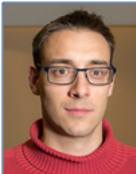 |
Matevž Domajnko - ESR7Fraunhofer – Institut für Graphische Datenverarbeitung, Darmstadt, GermanyUntil 30/09/2017 |
Matevž is from Slovenia where he had been working as a project and teaching assistant at the University of Ljubljana, Faculty of Civil and Geodetic Engineering, in the field of multimedia cartography and photogrammetry. His work encompasses 3D landscape visualization, GIS analysis and 3D point cloud modelling. At the same faculty he is conducting research on design principles in 3D cartography for his PhD. His Diploma thesis was entitled: »Designing of symbolic and photo-realistic 3D cartographic representation« and was supervised by Prof. Dušan Petrovič. After his graduation he spent 6 months at the Vienna University of Technology, where he deepened his knowledge of 3D cartography and 3D modelling under the supervision of Prof. Georg Gartner. In 2014 he moved to Darmstadt, Germany, to work for the Fraunhofer Institute for Computer Graphics Research IGD on the EU project ITN-DCH in the field of Image Processing and 3D Reconstruction. Here, he joined the team of the Competence Center Cultural Heritage Digitisation, which focuses on achieving fast and economic mass digitisation of 3D cultural heritage artifacts by automation and parallel processing technologies from images or videos. |
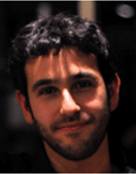 |
Nicola Carboni - ESR8Centre National de la Recherche ScientifiqueUntil 31/05/2017 |
Nicola Carboni is a Marie Curie Early Stage Researcher fellow within the CNRS - MAP Laboratory. He starts his academic career with a Bachelor degree from the University of Pisa in 2010. During these three years he focused on the different facets of the discipline, analysing the role of a cultural institute in the social development of a city. |
 |
Marleen de Kramer - ESR97Reasons Medien GmbH, Vienna, AustriaUntil 28/02/2017 |
Half German, half Dutch by birth, Marleen was raised in Germany and the United States and has spent the last 4 1/2 years living and working in Northern Ireland. She has now relocated to Vienna to work with 7reasons Medien. Originally, she trained as an architect at the University of Wuppertal, Germany, where she discovered her love of historic buildings. While working as a research assistant in the Institute for Architectural History and Theory (AGT), she finished her BSc with a final-year project comprising a practical design project, the adaptive re-use of a fire-damaged 19th-century music hall as a modern Wunderkammer, and a theoretical exploration of the significance of the curiosity cabinet in the development of the museum, both as a socio-cultural institution and as a building typology. She followed this up with several years of working in the heritage sector – primarily in practical conservation, heritage asset management, and education for the National Trust, the National Museums of Northern Ireland, and the Northern Ireland Environment Agency, and completed an MSc in Heritage Science at Queen’s University in Belfast. This course at the School of Geography, Archaeology and Palaeoecology focused on the digital documentation of natural and built heritage, including data capture, processing and presentation, and culminated in a Master’s Thesis that combined a multitude of data types to reconstruct the estate surrounding an 18th-century manor house from the Neolithic to the modern day. She looks forward to channelling her diverse interests and experience into the ITN-DCH project, and drawing on the varied expertise of her fellow researchers to make a real difference in the future of heritage. Her interest in history extends beyond her work; a passionate re-enactor, she practices Historic European Martial Arts (sword fighting and historic fencing) and is training her horse for mounted combat. Equally at home outdoors and in, she enjoys camping and hiking, but also readily admits to geekier pastimes such as tabletop gaming, comics, and sci-fi. |
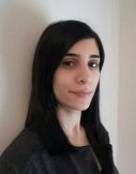 |
Margarita Papaefthymiou - ESR10FORTHUntil 31/07/2017 |
Margarita was born and raised in Larnaca, Cyprus. Her involvement in the ITN-DCH project focuses on geometric and illumination registration of dynamic AR scenes and gesture tracking and user activity recognition. She has a BA in Computer Science with a specialization in Computer Systems and Networks from the University of Cyprus. She recently acquired an MSc in the field of Computer Games and Interactive Technologies at the University of Cyprus in collaboration with the Cyprus University of Technology. Her MSc thesis focused on offering an efficient method that automatically extracts motion characteristics for synthesis of dance animation. The method leverages knowledge from anatomy, kinesiology, and psychology as incorporated in the motion analysis method ‘Laban Movement Analysis’. Her primary interests lie in virtual/augmented reality, artificial intelligence for games, computer graphics and especially computer animation. When in the mood, she enjoys a good walk, book or movie. |
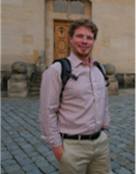 |
Matthew Luke Vincent - ESR11University of Murcia, SpainUntil 15/6/2016 |
For ITN-DCH, the title of his project is Virtual archaeology perspectives of tangible cultural content. He first got a taste of archaeology during his undergraduate studies at Walla Walla University in eastern Washington State. What he thought would be a once-off experience has now become the primary career goal and life focus. While Matthew is a dirt archaeologist and loves the experience of discovery and exploration that archaeology offers, he is also a technophile and has been since a very young age, primarily due to a nuclear engineer for a grandfather and the free access that afforded him to a school of engineering while still in gradeschool. Matthew recently completed his MA in Anthropological Archaeology at the University of California, San Diego through a National Science Foundation fellowship, the Integrative Graduate Education and Research Traineeship Program (IGERT) at the Center for Interdisciplinary Science in Art, Architecture, and Archaeology (CISA3). This program combined technology and archaeology together, fusing the two disciplines into a transdisciplinary approach for the preservation and study of cultural heritage. Before returning to graduate school to begin his MA in Anthropological Archaeology, Matthew spent five years working in the web application development world. Here, he developed skills fordatabasing, mobile applications and data modeling. These skills were applied to his primary archaeological project, Tall al-‘Umayri, through the creation of an online and mobile database for field recording and data publication, OpenDig. These days, Matthew continues to work with various projects in Jordan ranging from GIS and database specialist for Tall al-‘Umayri, co-director for the Balu’a Regional Archaeology Project and Cyber archaeologist for the Temple of the Winged Lion Project in Petra. When not digging or researching, he can be found pursuing one of his many hobbies: cycling, DIY electronics, traveling, and cooking. |
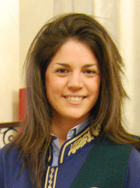 |
Vasiliki Nikolakopoulou - ESR12Digital Heritage Research Lab, Cyprus University of Technology, CyprusUntil 30/09/2017 |
Vasiliki Nikolakopoulou is from Athens, Greece, where she finished her Bachelor degree in Mathematics at the National and Kapodistrian University of Athens. During the last year of her studies she focused on applied research and applications. She continued with her Master Thesis in the area of Design of Interactive and Industrial Products and Systems from the University of Aegean (Syros, Greece). The results of her research, lead to the creation of an interactive application on multitouch table in order to enhance student’s learning and engagement in mathematics. During her MSc, she specialized on 3D modelling of industrial products, Computer Aided Manufacturing (CAM) and Engineering (CAE), Information Architecture, User Interface design and User Experience. Her involvement in ITN-DCH is concentrating on new techniques for data storage and archiving of massive and complex amounts of 3D/4D cultural assets by developing innovative methodologies for reusing such content in other domains. |
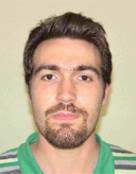 |
Simon Senecal - ESR13University of Geneva, SwitzerlandUntil 31/01/2017 |
Originally from France where he lived before joining the project. His involvement on the project is entitled Augmented and Mixed reality services for tourism and learning. He received his Bachelor’s in Physics from the University of Paris SudOrsay and then completed a Master’s of Physics in exchange at the National University of Singapore. Finally, he specialized in a unique multi-disciplinary Master’s: “Cognition, creation and learning sciences” he obtained from the Institute National Polytechnic de Grenoble, France. After several internships done during his studies in different fields of science (Astrophysics, Nuclear fusion, Nanophysics, Robotics), he got highly interested in Artificial life, virtual humans linked with cognitive sciences. Also passionate in history, he likes changing the scene of his lab by doing sport as natation or Judo, creating strange musical instruments and dancing salsa. |
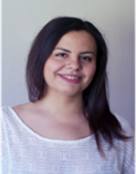 |
Nikoletta Skordaki - ESR14University of Ljubljana, SloveniaUntil 07/07/2016 |
She is a Chemical Engineer from Athens, Greece. Her participation in the ITN–DCH project is entitled Environmental factors in digital cultural heritage. She has studied chemical engineering in the School of Chemical Engineering of National Technical University of Athens and holds two Master degrees (MSc): a MSc in Mathematical modeling in Modern Technologies and Financial Engineering from the School of Applied Mathematical and Physical Sciences, N.T.U.A, as well as a MSc in Protection of Monuments from the School of Architecture, N.T.U.A. During her second MSc, Nikoletta was focused on the study of physicochemical and mechanical properties of building materials as well as on the study and the application of an integrated documentation methodology, structured upon quality control principles and relevant national, European and international standards, regarding the collection, recording and presentation of all data needed for the proper management of cultural assets (compatible conservation intervention and the use of building materials which are compatible to the authentic ones). During the MSc’s thesis she carried out research on two neoclassical building buildings in Athens, conducted participations in international meetings, and symposiums with corresponding publications. Nikoletta has also participated and helped in an international conference regarding protection of cultural heritage in Athens, an activity which contributed to the improvement of her communication, organization skills and teamwork. |
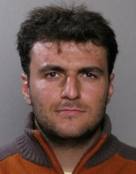 |
Emmanouil (Manolis) Alexakis - ESR15National Technical University of Athens, GreeceUntil 31/07/2016 |
Born and raised in the Municipality of Phaistos in Southern Crete of Greece. He has an interdisciplinary educational and research background in the fields of Applied Mathematics, Physical, Nuclear, Sustainable Energy and Computer Sciences and his involvement with the project is related to the computer aided Cultural Heritage Protection. After Manolis acquired his Diploma from the School of Applied Mathematical and Physical Sciences in the National Technical University of Athens (NTUA), he continued (and completed) his studies in the MSc of Sustainable Energy Technology in Delft University of Technology (TUD) in Netherlands. There, in parallel with his studies, he had a vivid research activity not only in Research Institutes like Nuclear Reactor Institute of Delft but also with the R&D industry sector. During his Diploma Thesis in NTUA, Manolis systematically investigated the FT-IR spectra of palygorskite; a natural hydrous magnesium aluminium phyllosilicate mineral being key constituent of the “Maya Blue” pigment. With regards to his MSc Thesis in TUD, he involved in the field of Big Data and more particular with Machine Learning and Artificial Intelligence; data mining in multidimensional databases in order to extract and integrate knowledge to leverage certain simulation processes. His overall objective is to create new potentials and eventually new knowledge in the sector of the Digital Cultural Heritage. When he is not behind his laptop screen you might find him in the kitchen (cooking), in a basketball-football court (playing) or somewhere in the countryside “exploring” the nature. |
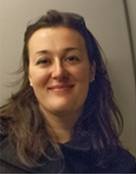 |
Rosella Suma - ESR16University of Warwick, UKUntil 31/05/2016 |
Rossella is Italian. She was born in Apulia, Italy, and she was living in Turin before joining the ITN-DCH project. She studied Computer Engineering at the Polytechnic University of Bari, Italy and while also attending the Conservatorio Niccolò Piccinni studying Piano Performance. Once she graduated from both institutions, she moved to Turin to attend the Polytechnic University of Turin pursuing a major in Computer Graphics, Virtual Reality and Artificial Intelligence. During her studies, she has been a consistent number of projects involving Digital Cultural Heritage. One of them was a 3D video game for educational purposes involving Egyptian burial rituals and accurately reproducing the Kha Thomb, which is one of the major displays at Turin Egyptian Museum. Her MSc thesis consisted in the creation of a library that provides programmers with a complete set of classes that assembles various human characteristics. This makes it possible to build smart agents thus increasing 3D historical building reconstruction believability. For a short period, she joined a Business Intelligence company and then she got the chance to be part of the ITN-DCH project. Her involvement relates to the creation of detailed computer models of historical example sites, the reconstruction and capture of light sources available at the sites and the authentic relighting of the sites using High Dynamic Range (HDR) imaging techniques. |










